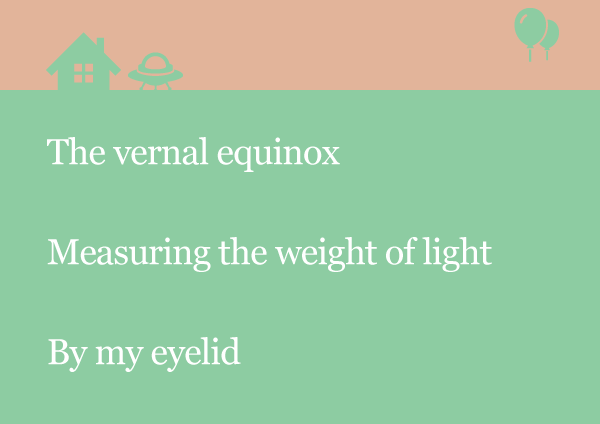Haiku Vernal equinox Measuring weight of light

Haiku Vernal equinox Measuring weight of light
俳句 Haiku:
The vernal equinox
Measuring the weight of light
By my eyelid
読上 Voice:
俳句 Haiku:春分の まぶたの裏に 乗る光
仮名 Kana:しゅんぶんの まぶたのうらに のるひかり
羅馬 Roman:Shunbun no Mabuta no ura ni Noru hikari
読上 Voice:
季語 Kigo:春 (Spring) > 3月 (March) > 春分 (Spring equinox Vernal equinox)
季節 Season:春 (Spring) > 中春 (Middle of spring)
意味 Meaning:
Kigo Shunbun (しゅんぶん 春分), or spring equinox, is one of the 24 solar terms (二十四節気).
Kanji 春 means "spring."
Kanji 分 means "to divide."
Therefore, kanji 春分 literally means "spring division" or "spring segment."
春分 comes after 啓蟄 (insect awakening) in the 二十四節気 (24 solar terms).
Around the vernal equinox, daylight hours become longer and nighttime hours become shorter. It has a worldview with momentum, flowing from dark to light, turning from yin to yang.
The essence of the kigo vernal equinox is "noticing a subtle change."
"Blooming cherry blossoms" and "budding plants" are good examples of the changes that are easy to understand for beginners.
On the other hand, those haikus are easy to fall into the trap of 月並俳句 (Tsukinami haiku Cliche haiku).
In order to advance from a beginner to an intermediate haiku writer, find out "a subtle change in your own life" as the material of your haiku. This "awareness of subtlety" is important.
The next solar term after the vernal equinox is 清明 (Seimei Clear bright) when the atmosphere becomes clear and bright. The season goes on and the ecliptic longitude turns from zero degrees to 15 degrees.
解題 Commentary:
多言語対応 Multilingualism:
韓文 Hanguel:한글 춘분 (チュンブン) 발음 춘분 (チュンブン) RR2000 chunbun MR1937 ch’unpun
中文 Chinese:繁体 春分 簡体 春分 (chūnfēn chun1fen1 チュンフン)

質問と回答